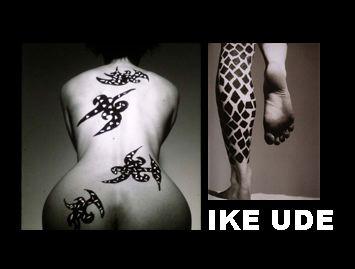Ike Ude
dal 11/9/2002 al 8/11/2002
Segnalato da
Fifty one Fine Art Photography
11/9/2002
Ike Ude
Fifty One Fine Art Photography, Antwerp
His photography is infused with critical references to fashion and the media, and he investigates fashion photography as a distinct type of performance documentation. His send-ups of stock fashion poses and sexual stereotypes undermine the tenuous balance between perception and reality that fashion features and ads work so hard to achieve.

Nigerian-born Iké Udé has been living in New York City since 1982, but
first received critical attention in the mid-1990s as a result of
participation in a number of highly acclaimed international exhibitions.
This attention was also an acknowledgment of Udés impact on an active
circle of New York artists during the 1980s, when his interest in
style, fashion, and media led to his founding of the magazine aRude.
Treating the magazine as a medium in its own right, Udé played multiple
roles in its production.
Udés art insists that, while the arts have played a key role in the
politics of visual culture and representation, media and fashion are
increasingly defining visual culture. His photography is infused with
critical references to fashion and the media, and he investigates
fashion photography as a distinct type of performance documentation. His
send-ups of stock fashion poses and sexual stereotypes undermine the
tenuous balance between perception and reality that fashion features and
ads work so hard to achieve.
Beyond Decorum: In the title series "Beyond Decorum" Udé gathers
well-worn high heel pumps and men's business shirts with ties and
replaces the labels with sexually explicit personal ads. Clothes become
both a cultural uniform and a costume. A traditional shirt and tie take
on alternative sexual meanings: appearances can be deceiving when
conservative dress pumps have a transgendered owner. By combining sexual
identities assumed to be on the fringe of society with mainstream
clothes Udé questions whether appearance determines thought or behavior.
In "Beyond Decorum" Udé makes sexual desires visible and in the process
points to the cultural taboos dividing public and private propriety. He
simultaneously normalizes that which is thought to be deviant and
uncovers the diversity behind a uniform appearance. Udé is fundamentally
interested in presenting complex identities that cannot be easily
reconciled with preconceived categories.
"Covergirls" is a series of enlarged color photographs of fabricated
magazine covers. At first glance Udé appears to be spoofing Vogue, Cigar
Afficionado, and Parenting but the critique is deeper than humor alone.
As in the series "Beyond Decorum" Udé creates a visual document for a
cultural absence. Here Udé becomes the 'covergirl' gracing the cover of
Cigar Afficionado as a black man in dramatic drag make up and on
Parenting as a black baby on a walk with his white nanny. While Udés
identity changes from cover to cover the monotony of the traditional
upper-class white cover model becomes apparent.
The "Covergirl" series recalls many historical influences from Andy
Warhol's multi-media, pop art fascination with the creation of celebrity
and more recently Cindy Sherman's use of costuming to explore the
cultural icons and stereotypes of women. Warhol used repetition and
methods of mass-production in his portraits of well-known faces to
suggest that public identities were produced rather than natural. And to
a similar end Sherman makes her portraits of well-known cultural roles
overtly theatrical to unveil the superficiality of these stereotyped
personalities.
Udé, however, not only points out the construction of stereotyped
cultural identities but also sets out to present the complexity and
diversity within and among these culturally defined identities. He does
this by presenting identities that straddle several characteristics at
once: the confident black man, the privileged upper-class
connoisseur, the effeminate transsexual, and the international man with
an African family history.
ULI Serie : Even in his most formal and politically subtle series of
untitled black and white nudes, the issues of identity are brought to
the forefront. Udé uses the conventions of the tradition of nudes in
photography and the seduction of a broad tonal range black and white
print to highlight skin as the ultimate cultural costume. In Udé's
versions of the nude he takes partial body shots and never includes the
figure's face to eliminate the possibility that these are portraits of
individuals. He draws attention to the color, texture, surface of the
skin by painting decorative patterns across the bodies of the figures in
a contrasting color. To exaggerate his emphasis on the surface and
appearance of the figures' skin some photographs include a light skinned
body juxtaposed with a dark skinned one. Nevertheless, the identity,
race, culture, and often the gender of the figure is completely
ambiguous. Skin, that costume that is considered the most immutable
determinant of identity, is rendered as a decorative covering.
by Mitra Abbaspour
FIFTY ONE FINE ART PHOTOGRAPHY
ZIRKSTRAAT 20
2000 ANTWERPEN
BELGIUM
T:32-3-2898458
F:32-3-2898459



